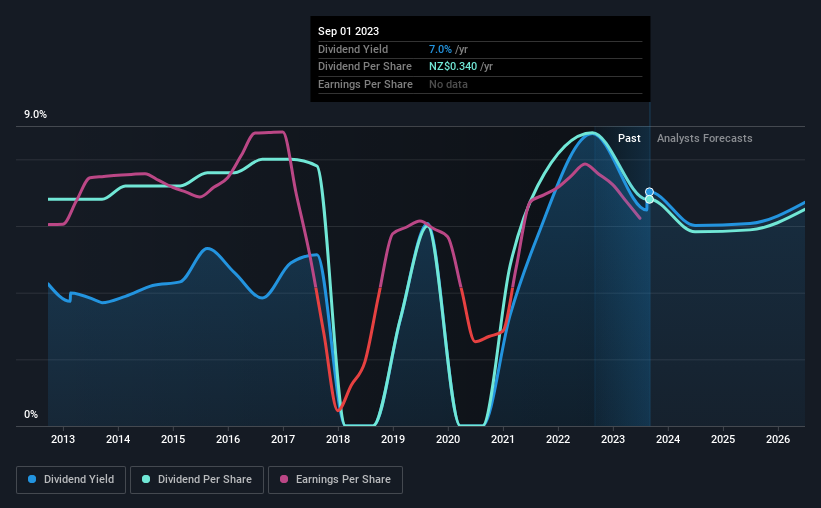Fletcher Building's (NZSE:FBU) Dividend Will Be Reduced To NZ$0.1882
Fletcher Building Limited (NZSE:FBU) has announced that on 5th of October, it will be paying a dividend ofNZ$0.1882, which a reduction from last year's comparable dividend. The yield is still above the industry average at 7.0%.
View our latest analysis for Fletcher Building
Fletcher Building's Payment Has Solid Earnings Coverage
A big dividend yield for a few years doesn't mean much if it can't be sustained. Based on the last payment, earnings were actually smaller than the dividend, and the company was actually spending more cash than it was making. Paying out such a large dividend compared to earnings while also not generating free cash flows is a major warning sign for the sustainability of the dividend as these levels are certainly a bit high.
Over the next year, EPS is forecast to expand by 69.9%. If the dividend continues along recent trends, we estimate the payout ratio could reach 75%, which is on the higher side, but certainly still feasible.
Dividend Volatility
The company has a long dividend track record, but it doesn't look great with cuts in the past. The last annual payment of NZ$0.34 was flat on the annual payment from10 years ago. It's encouraging to see some dividend growth, but the dividend has been cut at least once, and the size of the cut would eliminate most of the growth anyway, which makes this less attractive as an income investment.
Fletcher Building Might Find It Hard To Grow Its Dividend
Growing earnings per share could be a mitigating factor when considering the past fluctuations in the dividend. Fletcher Building has impressed us by growing EPS at 34% per year over the past five years. Although earnings per share is up nicely Fletcher Building is paying out 113% of its earnings as dividends, which we feel is borderline unsustainable without extenuating circumstances.
Fletcher Building's Dividend Doesn't Look Sustainable
In summary, dividends being cut isn't ideal, however it can bring the payment into a more sustainable range. While we generally think the level of distributions are a bit high, we wouldn't rule it out as becoming a good dividend payer in the future as its earnings are growing healthily. This company is not in the top tier of income providing stocks.
Investors generally tend to favour companies with a consistent, stable dividend policy as opposed to those operating an irregular one. However, there are other things to consider for investors when analysing stock performance. For example, we've identified 3 warning signs for Fletcher Building (1 is significant!) that you should be aware of before investing. Looking for more high-yielding dividend ideas? Try our collection of strong dividend payers.
Have feedback on this article? Concerned about the content? Get in touch with us directly. Alternatively, email editorial-team (at) simplywallst.com.
This article by Simply Wall St is general in nature. We provide commentary based on historical data and analyst forecasts only using an unbiased methodology and our articles are not intended to be financial advice. It does not constitute a recommendation to buy or sell any stock, and does not take account of your objectives, or your financial situation. We aim to bring you long-term focused analysis driven by fundamental data. Note that our analysis may not factor in the latest price-sensitive company announcements or qualitative material. Simply Wall St has no position in any stocks mentioned.

